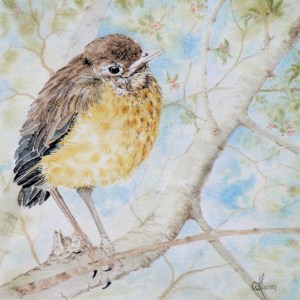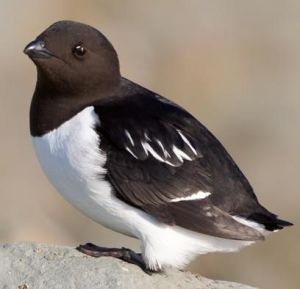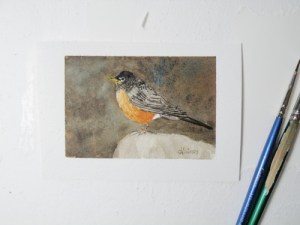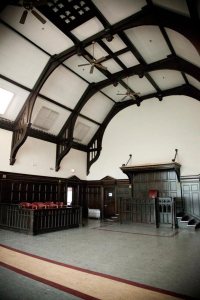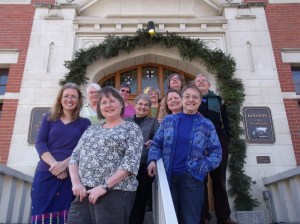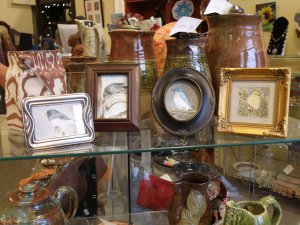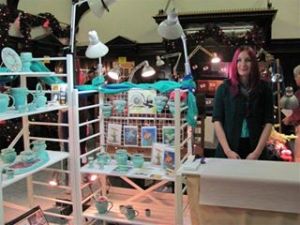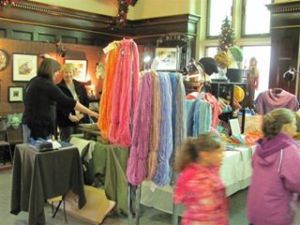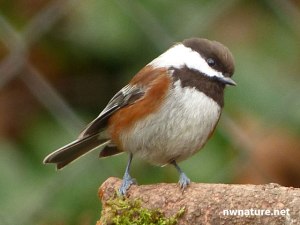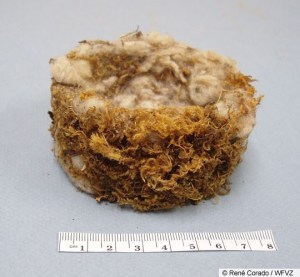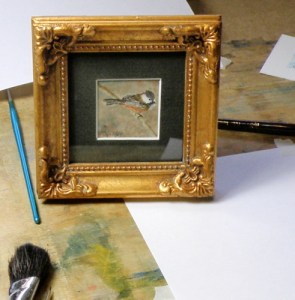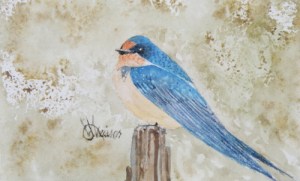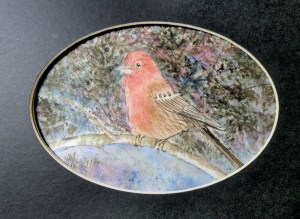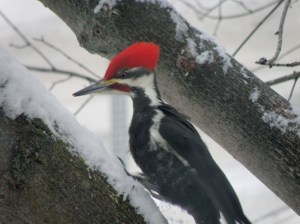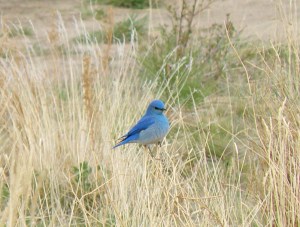when micro = macro
January 12, 2021

The largest bird on earth is–no surprise here–the Ostrich. Only the Emu comes anywhere close, and in N. America, our experience of the bird world (aside from some water birds and raptors) is most often an encounter with a species that is generally quite small. (Of course, after writing such a declarative sentence my mind’s eye gets filled with Ravens, Magpies, Embden Geese, Roosters and Pileated Woodpeckers, lol.)
Songbirds in particular are relatively tiny, thus lending themselves well to tiny portraits, which, when I was still a member of a Gallery, sold quite steadily and well.
The ‘how’ of ACEOs
April 6, 2018
To gain more know-how about the way ACEOs are collected and acquired, just go to eBay and view the huge number of them being sold/auctioned: https://www.ebay.com/sch/i.html?_nkw=aceo+original+painting&_sacat=0&_from=R40
You’ll see the quality contrasts, the styles, the subject matter variety, the variety of mediums, too–as well as price, with some going for $40/ea to $1/ea.
Below are examples of how I personally approach doing ACEOs:
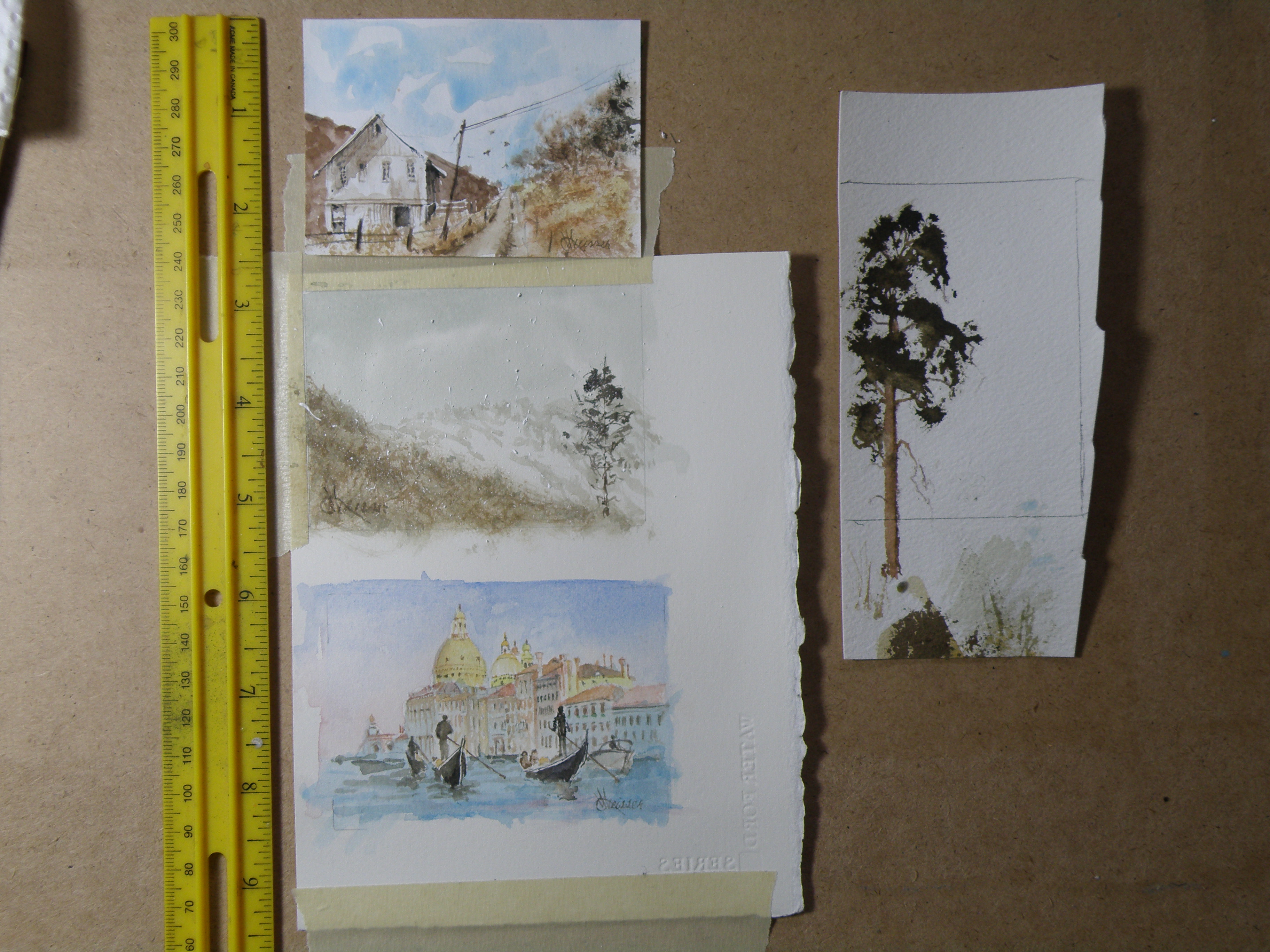
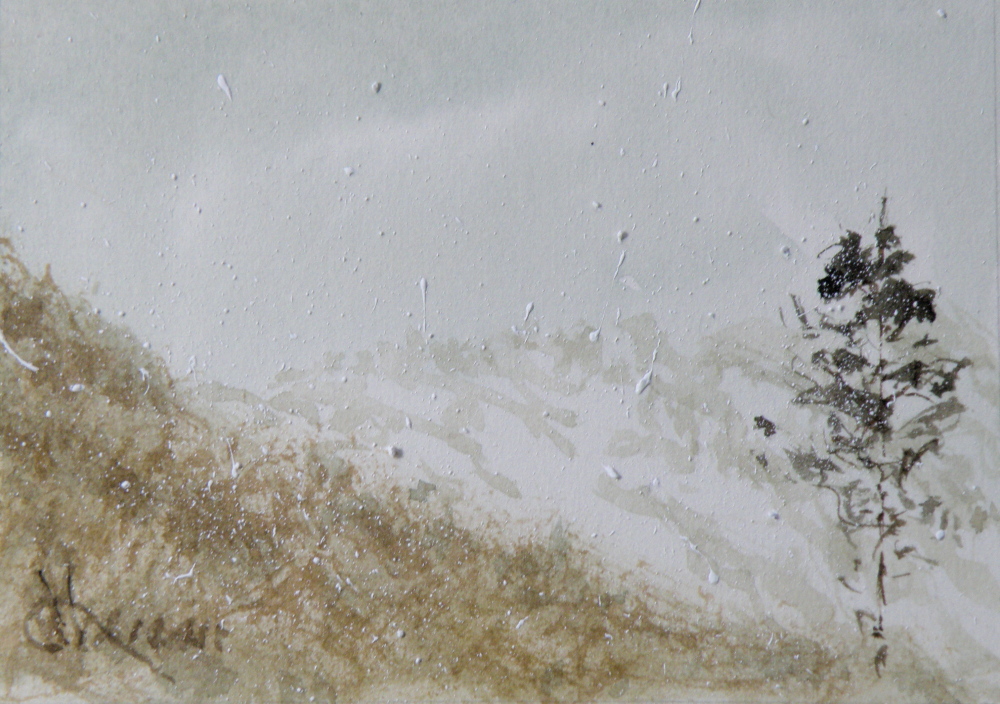
‘A Westsyde Winter’, ACEO by Lance Weisser, Arches Hot Press 140 lb Paper, sold.
Once one of mine is matted and framed, it is generally priced at $25 to $30US. Unframed, $20US. But I’m not beyond letting interested people barter for them because what is most pleasing to me is having a person get an original watercolour that is within his/her means. As painters, we really just want people to enjoy what we do, and know our work is being appreciated and displayed.
If interested, please just email me at weisserlance@gmail.com.
I can work from an emailed attached photo, or your personal subject matter ideas. It can be mailed to you wherever you may be — postal costs will be built into the final price 🙂
ACEOs (miniature art cards)
April 3, 2018
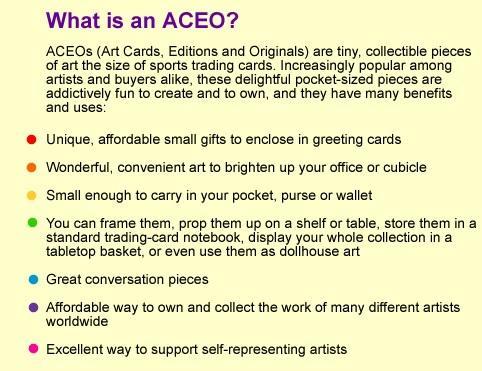
[source: https://creationsbygena.zibbet.com]
An ACEO is 2.5″ x 3″ — artwork the size of sports trading cards — otherwise known as a miniature. I personally love the challenge of painting something that small.

Old Barn, watercolour ACEO, 2.5″ x 3″, Arches Hot Press 140 lb paper. Sold.
Have you ever done them or bought one? I’d be interested to know!
The Least Chipmunk
January 17, 2018
When taking our Jeep in for servicing, the attendant came to me with what had been an air filter and was now a chipmunk house. I instantly knew which one–the one which seemed to be everywhere as late Summer progressed and Autumn loomed.
The Least Chipmunk is so named because it is the smallest in our continent and can easily turn an air filter into a roomy apartment. It, like all its kind, eats just about anything, including insects, nuts, berries, mushrooms, and tree buds.

The Least is so small a full grown adult weighs only two ounces. There are plenty of predators in our area, including many hawks, coyotes, owls and rattlesnakes. There are also a variety of potential homes, including Jeep air filters.

‘Least Chipmunk’ watercolour on Arches Hot Press 140 lb., 4″ x 4″, sold
… a little Junco
May 3, 2016
My observations are that birds which winter over are more agreeable in disposition than birds which come here to breed. Case in point, Juncos, which winter over here and then head further North to breed. They are such a delightfully polite and agreeable little bird, not taken to fighting over the feeders, but rather preferring to peacefully forage below them.
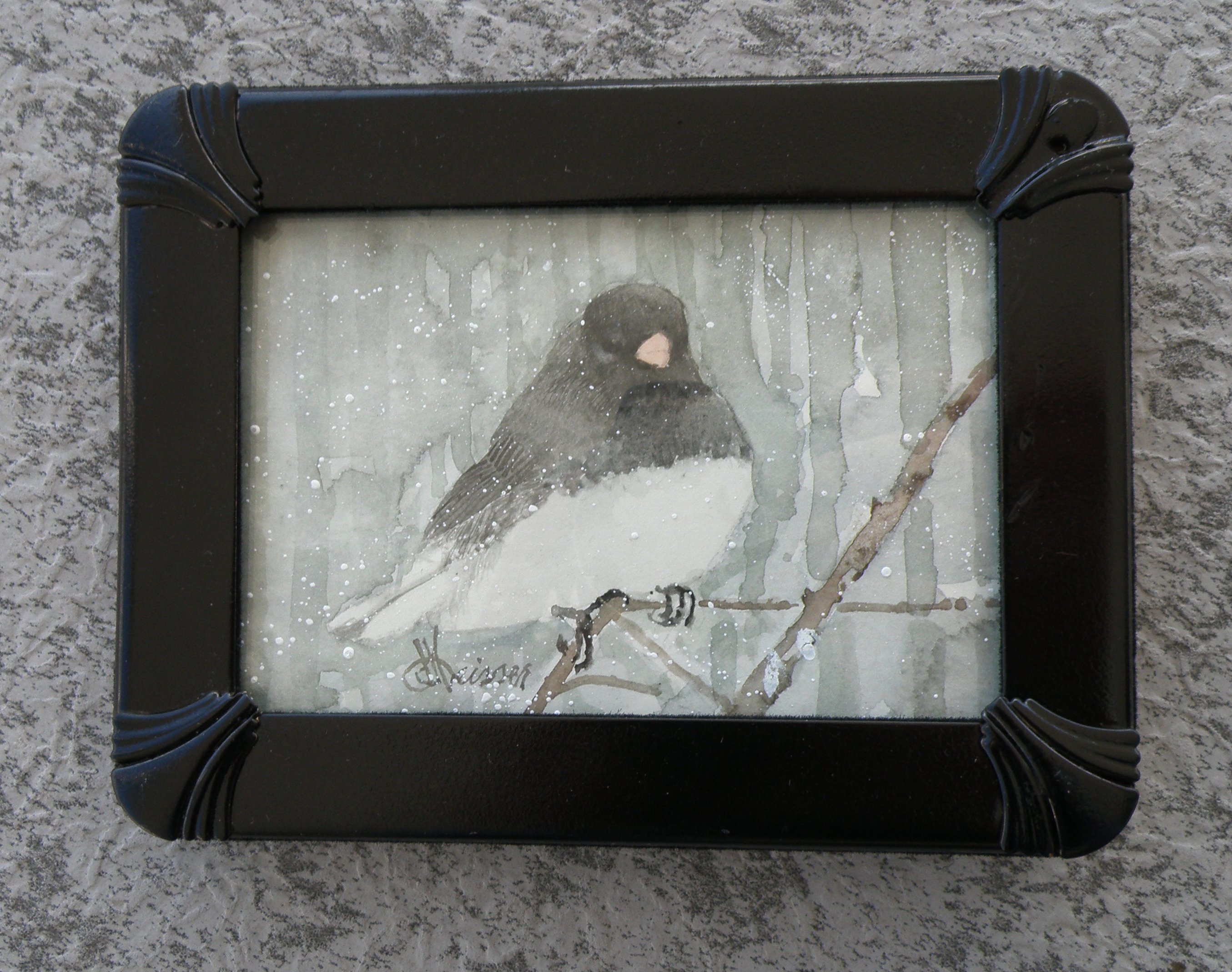
‘Dark-eyed Junco’
3″ x 5″, watercolour on Saunders Hot Press 140# Paper
On the other hand, birds which migrate here to breed, like the Common Grackle, dive-bomb me when I’m giving our dog Elmo his early morning walk, as though I am suddenly in my dotage going to start climbing trees to pull down their nests.
But blest be the birds which come here to winter over, like the so-lovely Common Redpoll and the Dark-eyed Junco. Although extremely territorial when nesting, we get to see Juncos when sex is the furthest thing from their bird-brained minds and finding seeds on the snow is all they care about.
Some birdie facts:
- Juncos are the “snowbirds” of the middle latitudes. Over most of the eastern United States, they appear as winter sets in and then retreat northward each spring. Some juncos in the Appalachian Mountains remain there all year round, breeding at the higher elevations. These residents have shorter wings than the migrants that join them each winter. Longer wings are better suited to flying long distances, a pattern commonly noted among other studies of migratory vs. resident species.
https://www.allaboutbirds.org/guide/dark-eyed_junco/lifehistory
….cedar waxwing
April 23, 2016
As a kid, having to enter the annual Science Fairs in Jr. High–the ones where invited experts walked around with clipboards trying to find possible prize winners–I had exhibits which were often concerned with birds–songbirds, usually–their migration patterns and predators, and fun facts.
I never won a prize. That usually went to kids who electrocuted themselves voluntarily in order to prove water and wires don’t mix–or the kids who cross fertilized seeds and created vegetative freaks.
The shortlist I had then in the 50s (living in upper New York State) was to see any kind of Bunting (they looked outrageously colourful), our State Bird the American Bluebird (which I never did see, and still haven’t), any kind of Tanager, and of course, any kind of Waxwing.
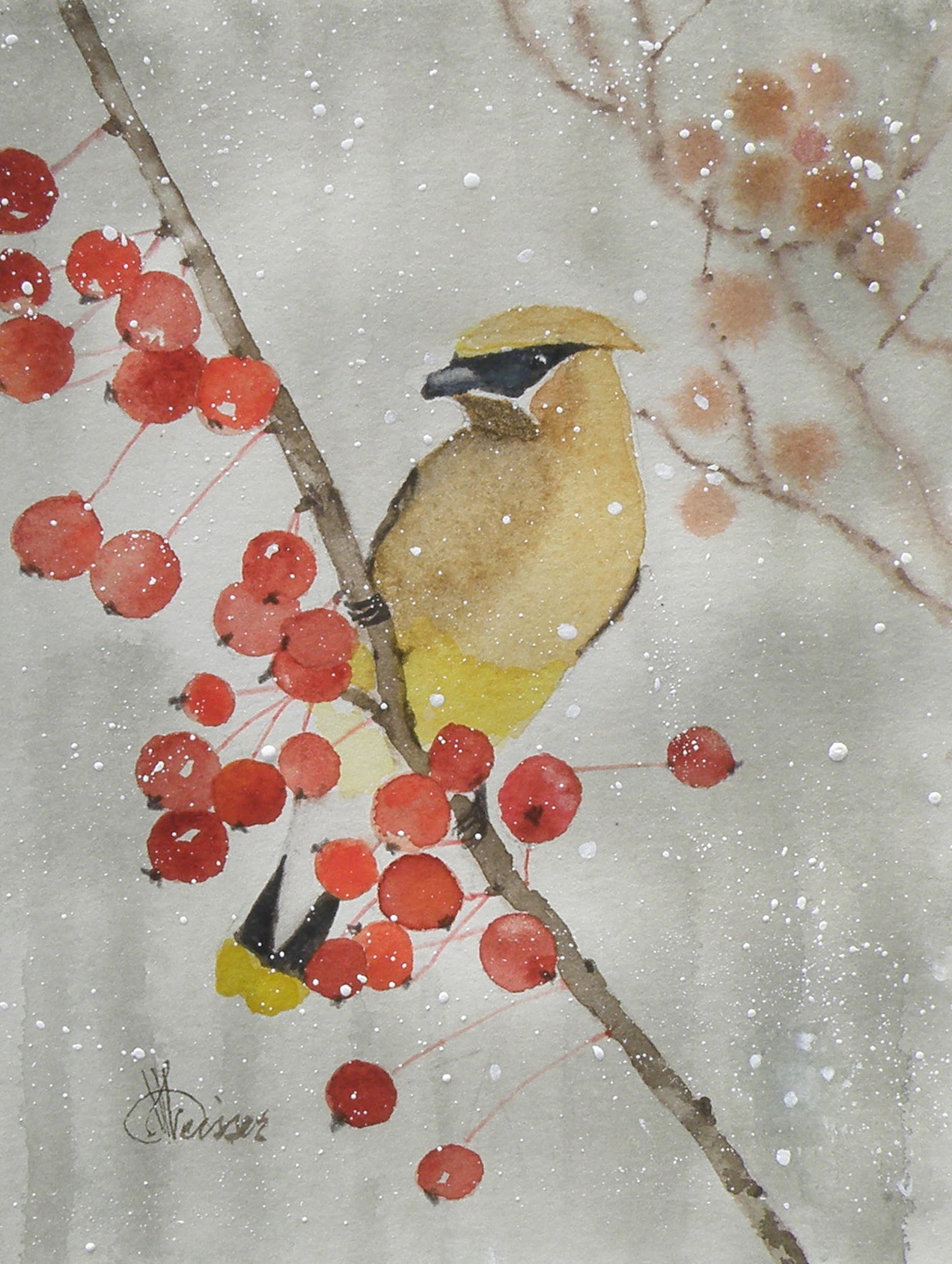
“Berry Picking”
Cedar Waxwing, 4″ x 6″, watercolour, Saunders Waterford Hot Press 140# Paper
Having lived now in seven different Canadian locations, from coast to coast, I’ve been able to photograph a Western Tanager in our front garden, a pair of Mountain Bluebirds (astonishingly blue), and a group of Cedar Waxwings which descended on our Red Maple branches and began dismantling a Robin’s nest, rather than having to bother scavenging their own material.
The Waxwings were much smaller than expected, and every bit as fascinating as I’d hoped. Their ‘bandit’s mask’ gives them an allure other birds lack, and their interesting ‘song’ and penchant for travelling about in flocks makes them worth having to wait 60 years to see them.
….Chickadee Miniature
April 21, 2016
This Winter along with the usual Mountain Chickadees at our feeders, we were pleased to have Black-Capped Chickadees as well. Coming from Eastern parts, they are the ones associated with childhood and so have a special place for me.
Right now we are experiencing amazingly warm temperatures–85F (30C)–and gardening is ramped up as a result. Dividing time between perennials and painting is a pleasure. As an Autumn and Winter person, I continue painting with that pallet of tones and colourations, and so ask you to cut some slack if/when I post snow scenes in April.
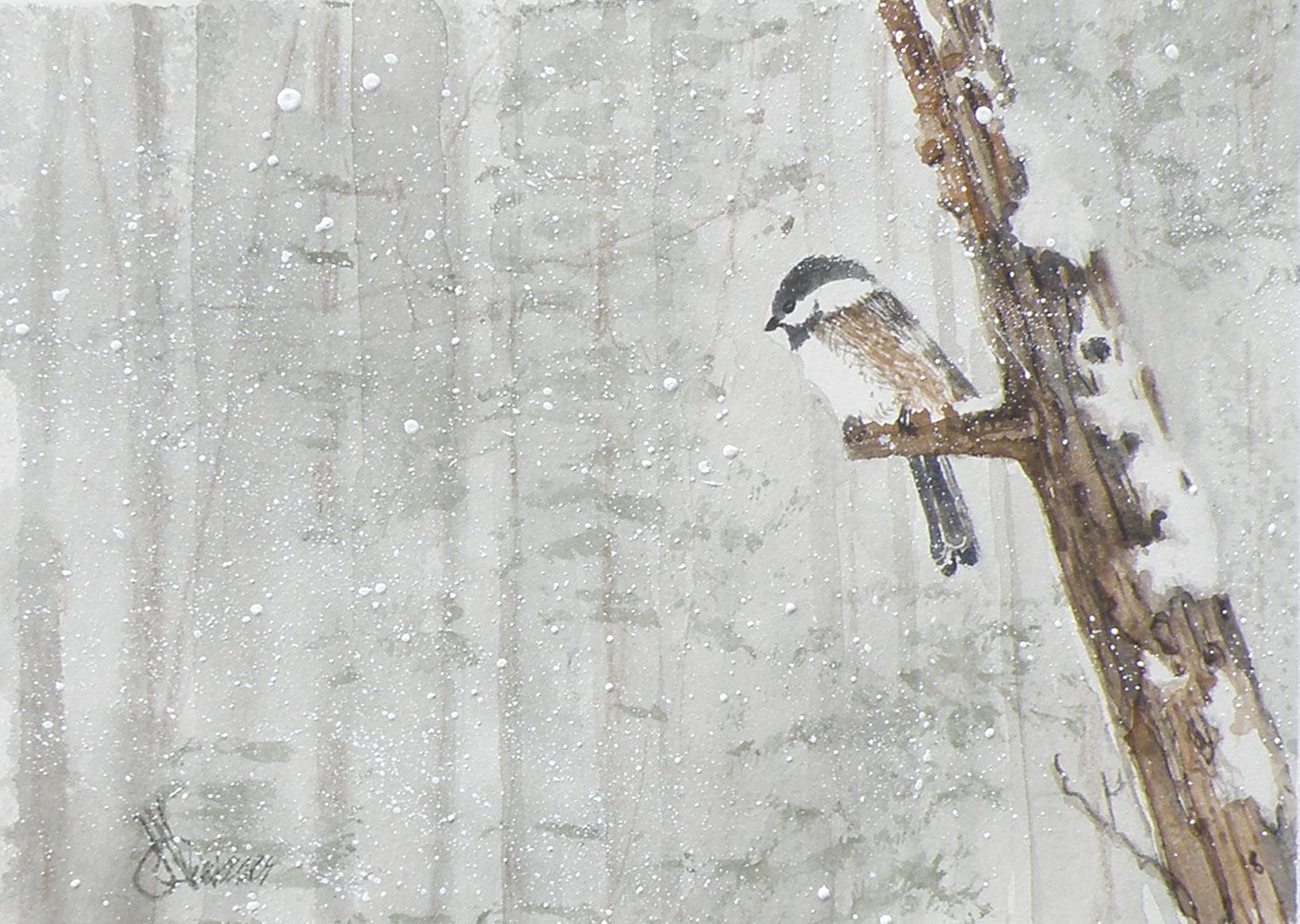
‘Pause That Refreshes’
5"x 7", Watercolour, Saunders Hot Press #140 paper
Cool Facts
- The Black-Capped Chickadee hides seeds and other food items to eat later. Each item is placed in a different spot and the chickadee can remember thousands of hiding places.
- Every autumn Black-capped Chickadees allow brain neurons containing old information to die, replacing them with new neurons so they can adapt to changes in their social flocks and environment even with their tiny brains.
- Chickadee calls are complex and language-like, communicating information on identity and recognition of other flocks as well as predator alarms and contact calls. The more dee notes in a chickadee-dee-deecall, the higher the threat level.
- Winter flocks with chickadees serving as the nucleus contain mated chickadee pairs and nonbreeders, but generally not the offspring of the adult pairs within that flock. Other species that associate with chickadee flocks include nuthatches, woodpeckers, kinglets, creepers, warblers and vireos.
- Most birds that associate with chickadee flocks respond to chickadee alarm calls, even when their own species doesn’t have a similar alarm call.
- There is a dominance hierarchy within flocks. Some birds are “winter floaters” that don’t belong to a single flock—these individuals may have a different rank within each flock they spend time in.
- Even when temperatures are far below zero, chickadees virtually always sleep in their own individual cavities. In rotten wood, they can excavate nesting and roosting holes entirely on their own.
- Because small songbirds migrating through an unfamiliar area often associate with chickadee flocks, watching and listening for chickadee flocks during spring and fall can often alert birders to the presence of interesting migrants.
- The oldest known wild Black-capped Chickadee was at least 11 years, 6 months old when it was recaptured and re-released during banding operations in Minnesota.
source: https://www.allaboutbirds.org/guide/Black-capped_Chickadee/lifehistory
….House Finch miniature
April 16, 2016
It is so heartening to have requests from bloggers and site visitors who have arranged to have original bird miniature paintings sent to them. The last posting of the Raven miniature, “Keeping Watch”, is currently winging its way to Hawaii, and the March 5th miniature entitled “Raven Moon” is sitting on Byron’s desk in Wisconsin. Another of a wintering Chickadee is with its new owner, Cynthia the poet, https://littleoldladywho.net/ in Maine.
Some bird species are seemingly germain to just about anywhere, the House Finch being one. When we moved from Eastern Canada to extreme Western Canada, there they were. And on fellow blogging sites like H. J. Ruiz’ Avian 101 (https://avian101.wordpress.com/), there they are in the Peach State of Georgia.
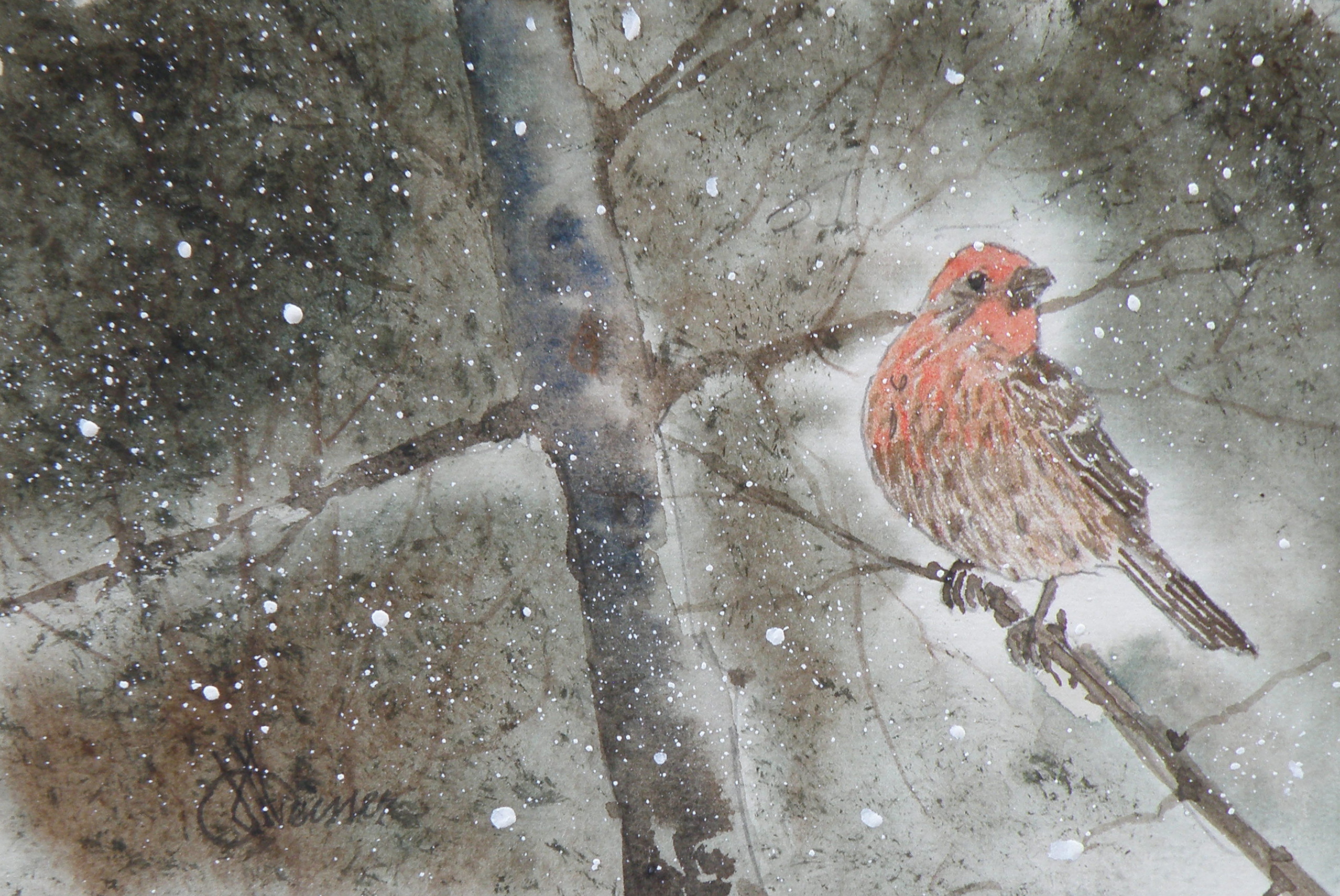
‘House Finch’ — watercolour on Saunders Waterford 140# Hot Press Paper, 2.5″ x 4″
They are, along with wintering Goldfinches, the most frequent visitor to our feeders, and have such a delightfully melodious song. Unlike the slightly larger Purple Finch which probably isn’t found in the West, they do not so much look like they’ve been dipped in raspberry concentrate, as they’ve stuck their heads in wild cherry cream soda. Their disposition is mild, insofar as they aren’t pushy or argumentative when at the feeders. If another species is bossy, they simply flit down to the snow and eat the remains below, along with the Juncos.
If you are ever interested in owning one of these posted bird miniatures, simply email me at: weisserlance@gmail.com and we’ll work out the arrangements. Thank you to all who are so very supportive in comments and visits!
…..Keeping Watch
April 7, 2016
Our little Gallery in the small city of Kamloops, B. C.’s historic Courthouse (1911) has a Featured Artist offering every month and May will be my month to put on a display of recent miniatures. So now it is a matter of working towards having a good showing.
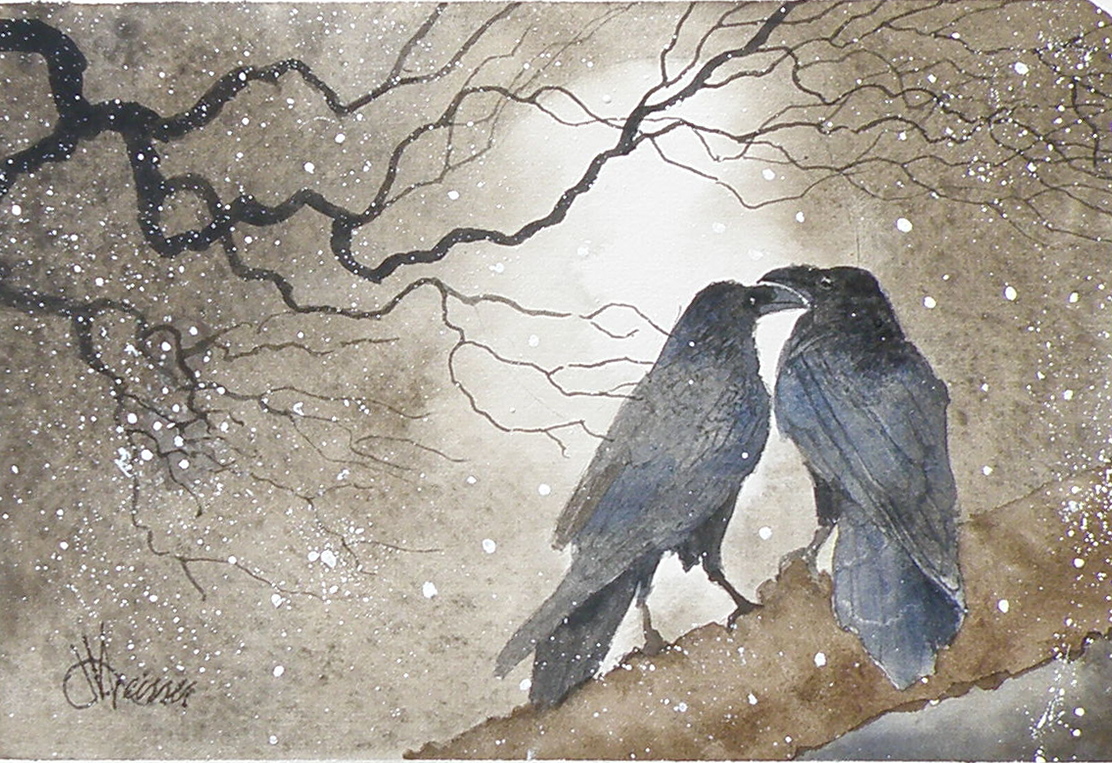
“Keeping Watch”
watercolour on Saunders Hot Press #140 lb paper, 4″ x 6″
I can’t quite explain why it is that depictions of Ravens sell so well, but they do. So it is a pleasure to be able to comply and feed the need, so to speak. They are indeed a very symbolic and ancient bird whose fame is heralded in many countries and cultural legends concerning them abound.
Out taking photographs of them this week, I came across a pair whose size was truly astonishing and whose throaty calls echoed off the nearby boulders and across the wide Thompson River. Once that is accomplished, it is a matter of trying to place them in a scene which has definite mood and emotional impact.
….draw a bird day
March 8, 2016
Teresa Robeson reminded me of ‘bird day’ (https://wordpress.com/read/feeds/4736591/posts/949345080#comments) with her striking rendition of an exotic Araripe Manakin from Brazil.
Here is a far more humble (don’t tell it that!) species, but at least I’m doing my birdy duty this Tuesday morning…..
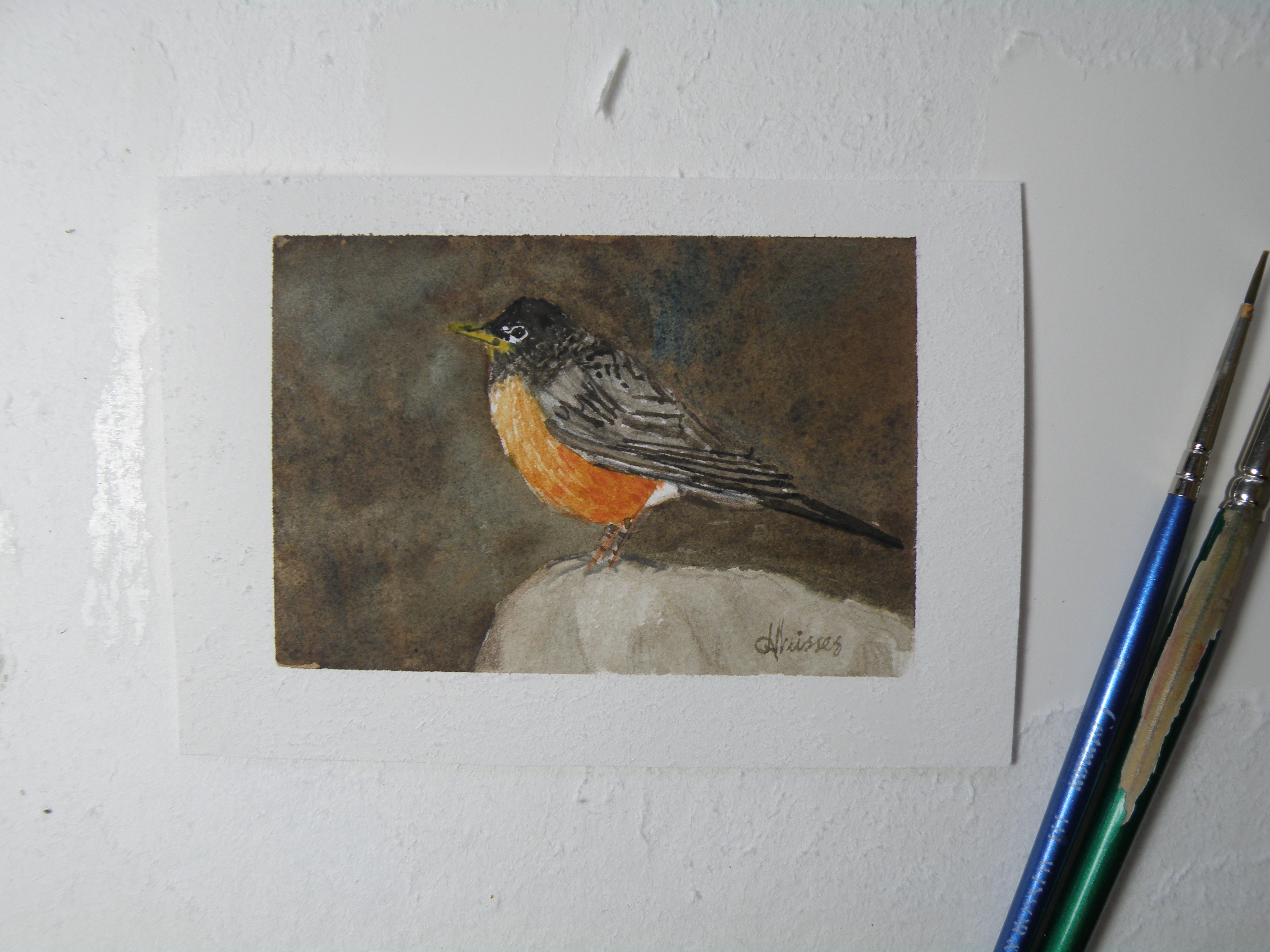
1.5″ x 2″ on Arches Hot Press 140# Paper
I saw my first one two weeks ago–around the third week of February–which is so early for this region, it is nuts. When they get here, they go for Mountain Ash berries and other withering, over-wintered types of fruit, until their usual fare of insects and worms become accessible. They are in breeding mode preoccupied with all their parental preparations.
….Raven Moon
March 5, 2016
Ravens sell very well in this neck of the woods, partially because they figure so prominently in our local Native legends–and partially because they are, as a species, so singular and distinctive. A customer pointed out to me that whereas Crows are very social (gathering together in great numbers), Ravens are solitary. Perhaps one of you can verify this comment–or add a correction?
This painting is 2.75″ x 1.75″ and, instead of putting it behind glass for protection, the decision was made to spray it with a durable fixative so the piece has more immediacy when viewed. I did include the glass in case the customer wishes to provide greater protection.
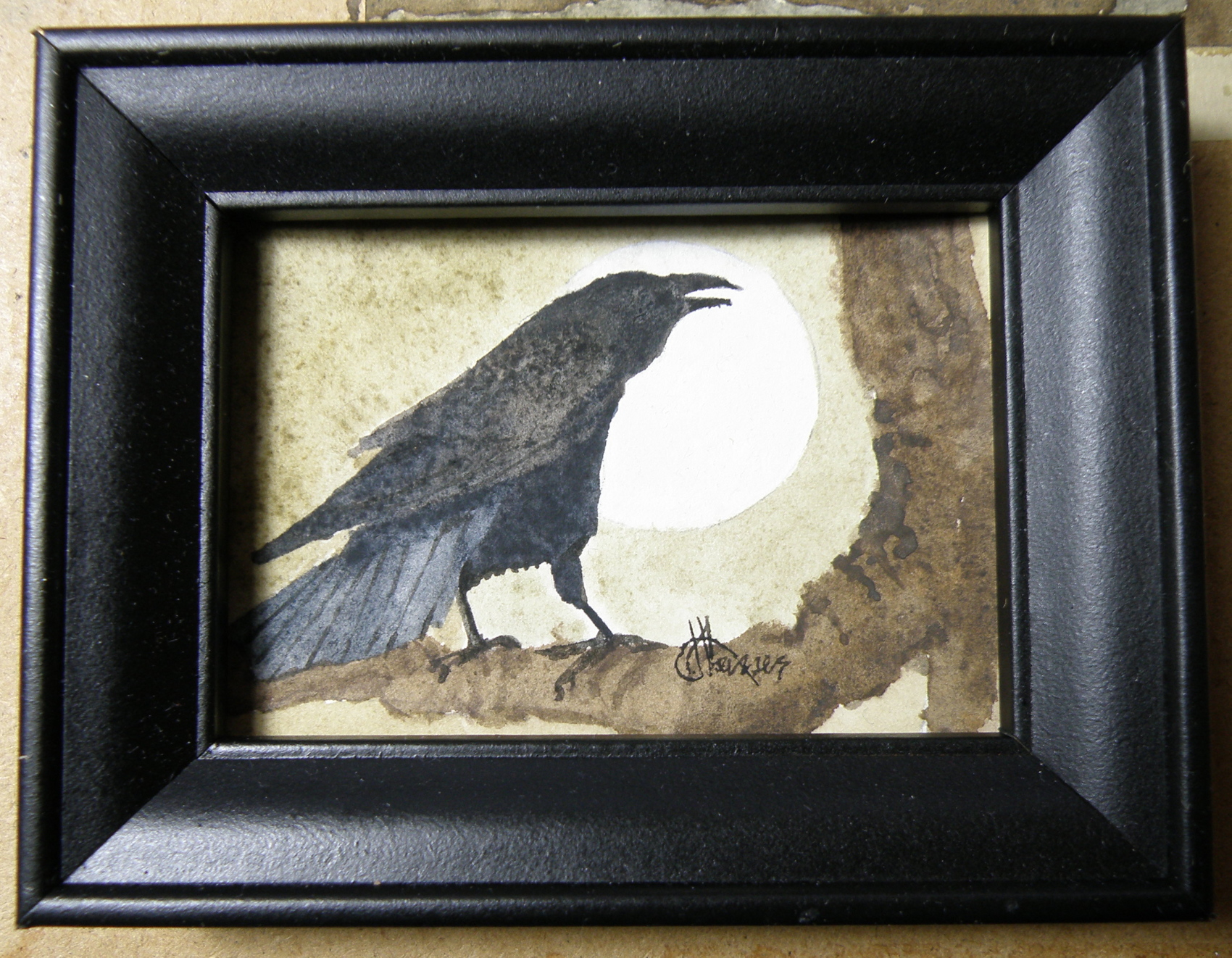
These bird miniatures can also be purchased from me through weisserlance@gmail.com for $30US (postage costs additional) unframed, $35US framed. Some buyers have chosen to select a suitable frame themselves locally and then email me the size the painting must be to fit their chosen frame. Then it is simply a matter of mailing off the painting in an envelope–easy-peasy. I have painted everything from someone’s favourite parrot (our late, great friend George Weaver’s prize pet) to exotic birds seen on a favourite trip and painted from a photograph supplied via attachment.
….a little nuts
November 20, 2015
Quite some months ago I asked Jackie of ‘Lost In Thought Photos’ (https://lostinthotphotos.wordpress.com/) for permission to do a miniature based on her wonderful photograph of a little tree squirrel.
Jackie very kindly agreed and emailed me back a very fine image of what –based on its colouration– appears to be a Fox Squirrel, which, even the most hardened rodent defamer would have to be a little nuts not to admit is cute.
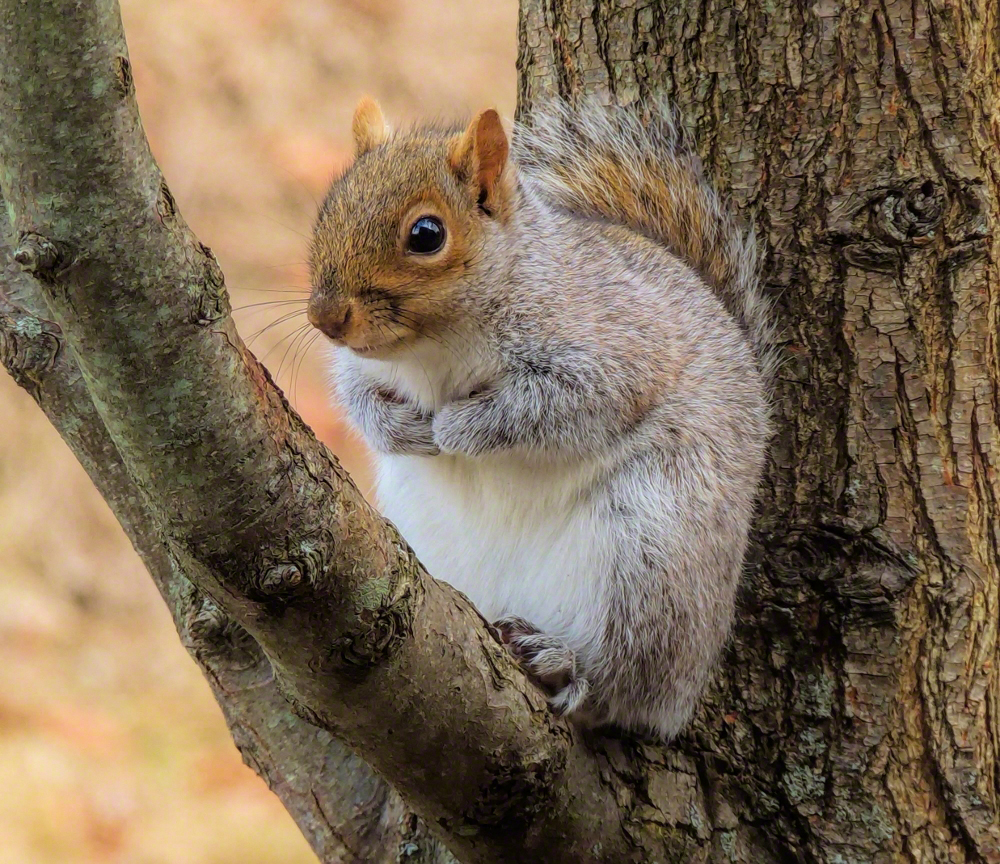
Here’s how they are described in Wikipedia: “. . . Fox squirrels are strictly diurnal, non-territorial, and spend more of their time on the ground than most other tree squirrels. They are still, however, agile climbers. They construct two types of homes called ‘dreys’, depending on the season. Summer dreys are often little more than platforms of sticks high in the branches of trees, while winter dens are usually hollowed out of tree trunks by a succession of occupants over as many as 30 years. Cohabitation of these dens is not uncommon, particularly among breeding pairs. . . ”
Besides their cuteness, it is charming that they are non-territorial, and have been known to share their homes. That is certainly not true for a great many squirrels, who seem to busy themselves hurling insults and chasing rivals all day long.
Hunting for frames is fun, losing myself in one or some of our ten or so 2nd hand stores, and recently resulted in this very nice (likely faux) leather 5″ x 7″ one for $.75. It allows this little painting to sell for $35.
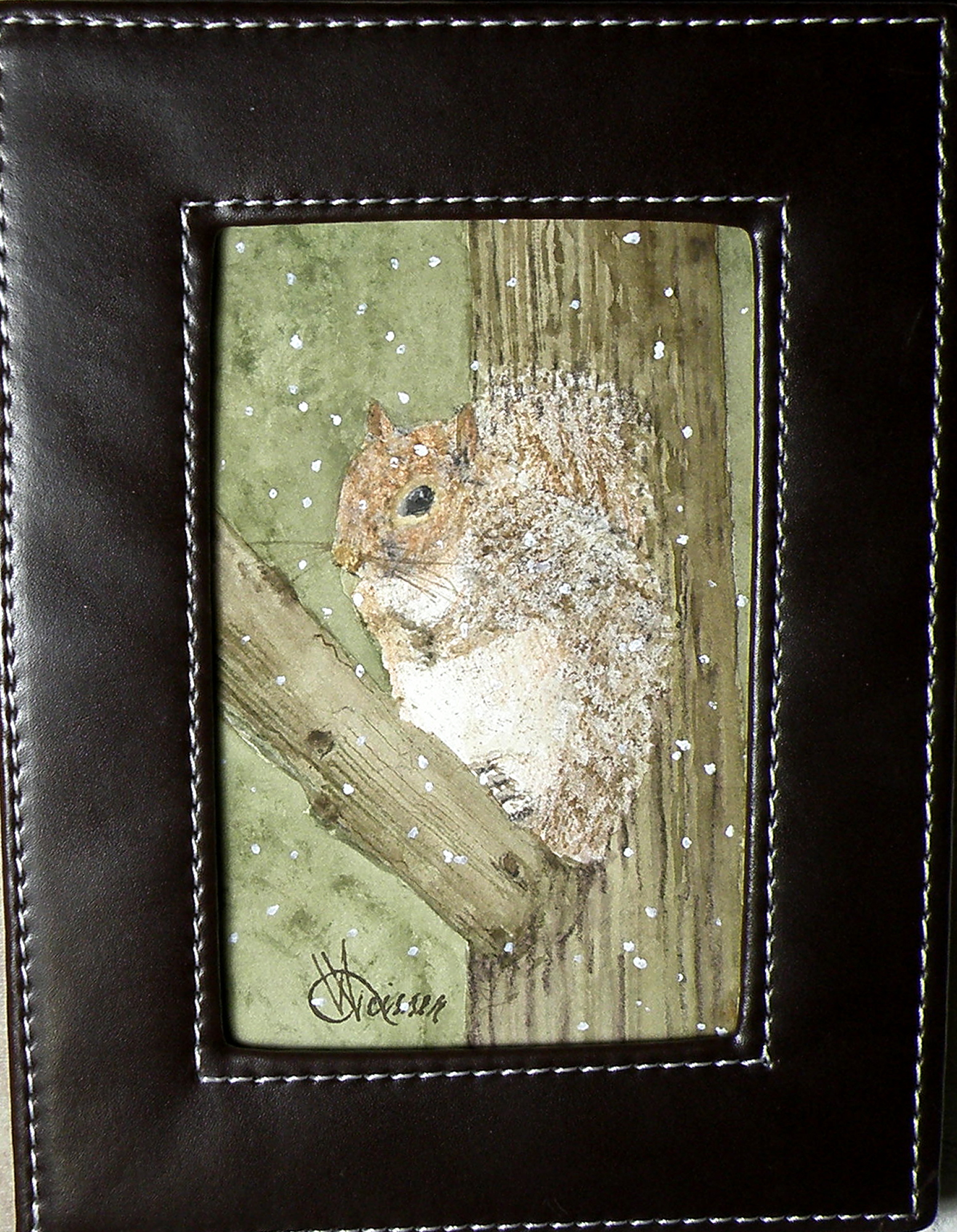
Our little Gallery keeps 20% commission. So many thanks to Jackie at https://lostinthotphotos.wordpress.com/ !
Draw A Bird Rewind . . .
September 1, 2015
Laura of Creatarteveryday has thrown down the gauntlet, and we’re rising to the challenge (even if it is a repost!)
So here goes, Laura. . . .
Juvenile N. American Robin, done on commission for J. Leckie, Christmas, 2011
Your turn! Follow Laura at https://wordpress.com/read/post/feed/32739058/794878009
rufous hummingbird miniatures
July 18, 2015
The rufous hummingbird (Selasphorus rufus) is a small hummingbird, about 8 cm (3.1 in) long with a long, straight and very slender bill. These birds are known for their incredible flight skills. Some are known to fly 2,000 mi (3,200 km) during their migratory transits.
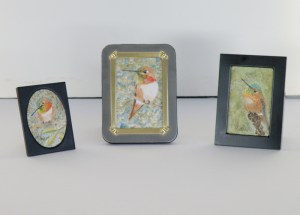
Rufus & Allen’s Hummingbird miniatures, approx. 3.8cm x 5cm (1.5″ x 2″), Arches Hot Press 140 lb. paper
The adult male has a white breast, rufous face, upper-parts, flanks and tail and an iridescent orange-red throat patch or gorget. Some males have some green on back and/or crown. The female has green upper-parts with some white, some iridescent orange feathers in the center of the throat, and a dark tail with white tips and rufous base. Their breeding habitat is open areas and forest edges in western North America from southern Alaska to California. This bird nests further north than any other hummingbird.
The female is slightly larger than the male. Females and the rare green-backed males are extremely difficult to differentiate from Allen’s hummingbird. (source: https://en.wikipedia.org/wiki/Rufous_hummingbird)
[In the photo above, the pre-dawn light produced a less-than-sharp picture. Photography is an artform unto itself. This is a digital image produced by a Kodak Brownie-type picture taker.]
atlantic puffin
July 13, 2015
The Atlantic Puffin is the only puffin native to the Atlantic Ocean and breeds in Iceland, Norway, Greenland,Newfoundland and many North Atlantic islands, and as far south as Maine in the west and the British Isles in the east. The Atlantic puffin has a large population and a wide range. It is not considered to be endangered although there may be local declines in numbers. On land, it has the typical upright stance of an Auk. . .
The Little Auk (Alle alle), is a tiny seabird, around the size of a starling
At sea, Atlantic Puffins swim on the surface and feed mainly on small fish, which they catch by diving underwater, using their wings for propulsion.
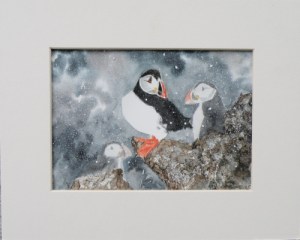
‘Atlantic Puffin’, watercolour miniature, 12.5cm x 17cm, (5″ x 6.5″), Arches Hot Press 140 lb. Paper
The Atlantic puffin spends the autumn and winter in the open ocean of the cold northern seas and returns to coastal areas at the start of the breeding season in late spring. It nests in clifftop colonies, digging a burrow in which a single white egg is laid. The chick mostly feeds on whole fish and grows rapidly. After about six weeks it is fully fledged and makes its way at night to the sea. It swims away from the shore and does not return to land for several years. (source: https://en.wikipedia.org/wiki/Atlantic_puffin)
(reference photo for painting from: Rolf Stange…www.spitzbergen-svalbard.com)
…..draw a bird day
July 8, 2015
Kwakiutl First Nation is a First Nations government based on northern Vancouver Island in British Columbia, Canada, focused on the community of Port Hardy, British Columbia in the Queen Charlotte Strait region.
A Kwakiutl Native legend has it that the eagle once had very poor eyesight. Because it could fly to the highest treetops, however, a Chief asked the eagle to watch for invading canoes. Anxious to assist, the eagle convinced the slug, which in those days had excellent vision, to trade eyes temporarily.
The slug agreed, but when the eagle’s sentinel duties were finished, the eagle refused to trade back eyes. Thus, goes the legend, not only is the eagle’s sharp vision accounted for, but also the slowness of the slug.
source: [http://www.baldeagleinfo.com/eagle/eagle-myths.html]
Laura, over at www.createarteveryday.com announced a challenge to draw birds today. And ‘Monday,Tuesday,Wednesday’ ‘s contribution was The Nevada State Bird, the magnificent Mountain Bluebird. Kirk’s contribution is The Baltimore Oriole, another gorgeous bird.
tiny robin
June 28, 2015
There is a woman named Robin who comes to the Gallery looking for namesake treasures. It is my personal pleasure to keep her mission accomplished.
I have a niece named Robin. What’s cool about her is that she is married to Peregrin. And the relieving detail is that they chose not to name any of their three children after birds.
I went to school with a girl named Candi Barr. When I was a kid, our next door neighbour’s maiden name was Olivia Greene. Fortunately, none of my (known) relatives ever named their son Bud.
Please provide some examples of your own known ‘unfortunate’ names. We could all do with a smile.
on display
June 22, 2015
THE OLD COURTHOUSE GALLERY CO-OP and Gift Shop got its start in 2007. The Courthouse itself is a Kamloops, B. C., landmark, built in 1909.
photo: Okanagan Art Review.com
A superb and intact example of the Edwardian Baroque style, its interior demonstrates an Arts and Crafts sensibility.
Mainly symmetrical, the building features an elaborate central entry, prominent parapet gables and a corner square-domed tower. It was constructed primarily of local brick, British Columbia stone such as granite, limestone and slate, and wood from local lumber mills. The choice of materials symbolized a commitment to the use of quality British Columbia products, a source of pride in this provincial building. An exceptional level of design and craftsmanship is evident throughout the building. It is one of the most accomplished designs of prominent architects Dalton & Eveleigh, and the stained glass came from the studio of Charles Bloomfield. (source: http://www.historicplaces.ca/en/rep-reg/place-lieu.aspx?id=12791)
Our Artists’ Co-op now consists of sixteen local artists, whose work is on display within one of the rooms of the original Courthouse. We are a group made up of several potters, glassmakers, jewelry makers, painters, two photographers, one dollmaker, and one weaver. I am currently the President.
Every month we schedule one or two of us to be the Featured Artists who occupy a special area just inside the entrance.
We are open five days a week, all year round, and our biggest event is called Christmas At The Courthouse where we invite and jury in arts and fine crafts vendors to sell their wares throughout the entire building . . .
chestnut chickadee miniature
June 16, 2015
The Chestnut-backed Chickadee uses lots of fur in making its nest, with fur or hair accounting for up to half the material in the hole.
nwnature.net
Rabbit, coyote, and deer hair are most common, but hair from skunks, cats, horses, or cows appears in nests as well. The adults make a layer of fur about a half-inch thick that they use to cover the eggs when they leave the nest. (source: allaboutbirds.org)
What’s not to like about these chittery, agile, and nimble bits of joy–so accommodating, they’re willing to eat out of an uplifted palm. At feeders, they flit in, impetuously seize a seed, cock their heads and in a mercurial moment are pounding the life out of their shell-encased prize, hammering against a solid branch.
When annoyed, they chee-chee-chee-chee at any feeder chaos, curtly muscle back in, and sprightly dart back up to pummel their sunflower seed in privacy.
Northern Mockingbird
June 12, 2015
TODAY MY BLOGGING COMRADE, H.J. Ruiz of ‘Avian101’ ( https://avian101.wordpress.com/2015/06/12/law-and-order-2/) features his stories and photographs of The Northern Mockingbird, a bird I was asked to do a miniature of, but not a bird which we (to my knowledge) have populating the Interior of British Columbia (it is probably just too cold here).
I HAD TO RELY ON REFERENCE PHOTOS and see from H. J.s photos that its feet are quite a distinctive size relative to the body. And it seems from photos to be a very sharp-eyed, inquisitive, decisive–almost wary–garden ‘defender’, as H.J. declares the Mockingbird to be. I’d perhaps have made its wings a degree darker had I had his photos before me, but I’m okay with the results.
OF COURSE, BOOMERS LIKE ME grew up hearing Patti Page singing ‘Mockingbird Hill’, as well as Inez and Charlie Foxx’s ‘Mockingbird’ (https://www.youtube.com/watch?v=g47_NI1CWNQ — which my parents hated and I loved ). It was, to me anyhow, later perfected by James Taylor and Carly Simon — watch here: https://www.youtube.com/watch?v=KmnTcBdpbHI . So all I really knew was the lore, rather than the bird.
AND I HAVE OVER THE YEARS, come to associate The Northern Mockingbird with The Old South, whether warranted or not, I just don’t really know.
finch miniature
May 28, 2015
THE HOUSE FINCH IS A RECENT INTRODUCTION from Western into Eastern North America (and Hawaii), but it has received a warmer reception than other arrivals like the European Starling and House Sparrow. That’s partly due to the cheerful red head and breast of males, and to the bird’s long, twittering song, which can now be heard in most of the neighborhoods of the continent. If you haven’t seen one recently, chances are you can find one at the next bird feeder you come across. (source: Cornell Ornithology)
WHEN WE LIVED IN QUEBEC it was easy to tell the difference between a House Finch and a Purple Finch, simply because one was red and the other was the shade of pickled beets. Truly, to me at least, the Purple Finch was the more impressive, whereas a House Finch sort of came across as a Sparrow who’d fallen into some cherry koolaid.
IN WESTERN CANADA we do not have Purple Finches. The House Finch has become a delight in its own right, particularly because it is indeed attractive, and has truly a most melodious and lovely song. They are not overly aggressive and take turns at the feeders with their usual companions, the Goldfinches.
wee glimpses
May 26, 2015
PAINTING OUTDOORS has a way of getting a person to make judgment calls quickly, and in our area it is quite simply the heat of the day.
KAMLOOPS, B.C., IS UNIQUE IN THAT its mountainous hillsides are grass-covered with considerable sagebrush but little tree growth to the 900m level, creating what is known as an inverted tree line.
IN MOST PLACES TREES WON’T GROW above a certain level due to the lack of precipitation, but in Kamloops, they won’t grow below a certain level due to the lack of precipitation. We are known as The Sunshine Capitol of Canada, receiving over 2,000 hours of sun annually.
IOW, IT IS HOT. And since sun and heat are our landscape’s signature features, painting a local watercolour outdoors demands sitting right the heck out there.
THAT IS WHY IT MAKES GREAT SENSE to me to choose to do this by way of painting miniatures.
MINIATURES demand quick thinking and choosing the elemental–the scene’s compositional essences–getting them down efficiently and thoughtfully, though, at the same time, quickly.
A GOOD MINIATURE can serve as the template for a much larger, studio piece. And good miniatures stand up very well all by themselves. This particular one has been accepted into two different juried Federation of Canadian Artists Shows, including the annual ‘Small, Smaller, Smallest’. It was, in that show, the very smallest of the lot. And that made me very happy!
showstoppers
May 22, 2015
SOME BIRDS ARE JUST LOOKERS. Here in the Southern Interior of British Columbia we have a few worthy of stopping traffic.
NOT BEING MUCH OF A PHOTOGRAPHER–a person who snaps pictures, really–I can only share my photos of some of our local showstoppers, the first being a …..
Tanagers come here to nest, as do many songbirds
ANOTHER LOOKER OF A BIRD is the …..
AND A GREAT FAVOURITE OF MINE IS a. . . .
THE MOUNTAIN BLUEBIRD is found here in our abundant grasslands, and are encouraged to remain by our local people building and mounting birdhouses meant especially for them. And truly there are no blues quite as brilliantly displayed as on a male Mountain Bluebird, who, while I was snapping away and adjusting my lense, remained surprisingly still and unperturbed, as though enjoying (and deserving) the attention.
RECENTLY I WAS ASKED TO PROVIDE A MINIATURE of a Male Northern Cardinal, a bird not found in Western Canada. Having to rely on images not my own, and hoping the result would do justice to the actual bird itself . . . .
IT IS BEING SENT OFF TO a patron in New York City, where I believe a Northern Cardinal might be seen gracing the beautiful environs of New York’s Central Park.
composition woes….
May 3, 2015
MY GREATEST CHALLENGE when painting anything is composition. For years I felt I was being a ‘purist’, insisting that I always paint on location, never in a studio setting. And once at the location, I convinced myself that if a tree was in that spot, then that was how it needed to be depicted.
IT WAS ALL DUE TO my tendency to early-on stop referring to the subject in front of me and become more and more involved in what was happening on paper, to the point where I may as well have not been on location at all. So in an effort at self-discipline, I decided that not only should I paint what things actually look like, I shouldn’t muck around with how and where ‘mother nature’ placed them.
THE SILLY THING WAS, I ended up choosing a composition by default because of course, I couldn’t paint everything my eyes saw in front of me. And more often than not, it was not a good composition. So now, not only do I go to some lengths to study the skill of creating an interesting arrangement, I realise it is the painter’s task to take what ‘mother nature’ provides and make art out of that. Fences do need to be repositioned, as do trees and hills and clouds.
SO NOW I MAKE thumbnail studies first on matt board before beginning anything . . .
THE OBJECTIVE is to provide a focal point, a visual way in towards it, then additional visual interest so the eye has more to discover by wandering beyond the subject itself. These thumbnails are exploring the use of a compositional figure ‘Z’ shape to lead the eye of the viewer.

